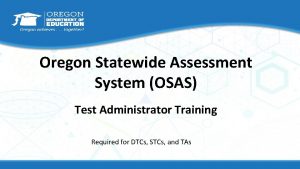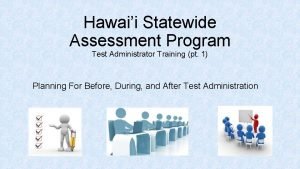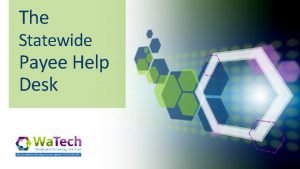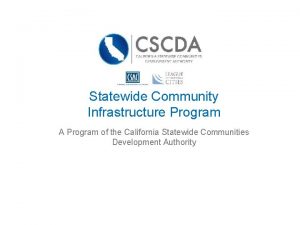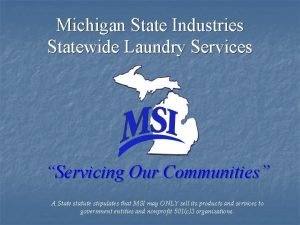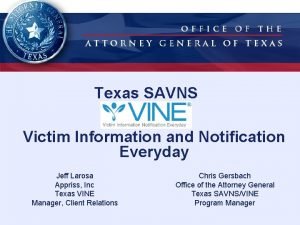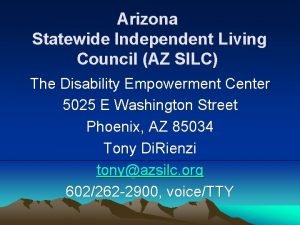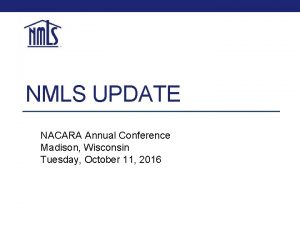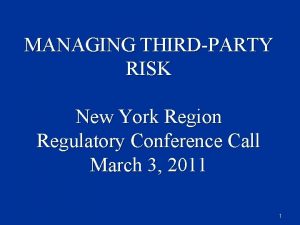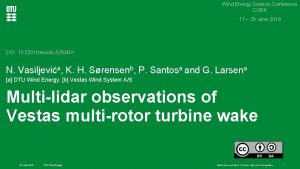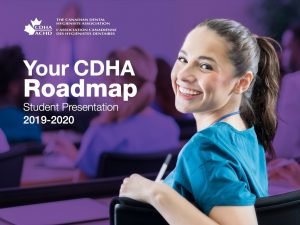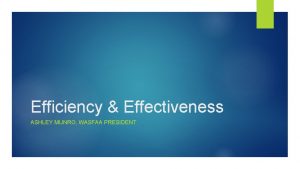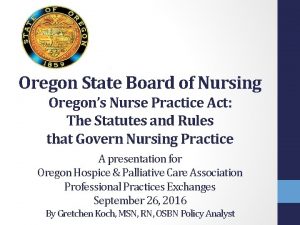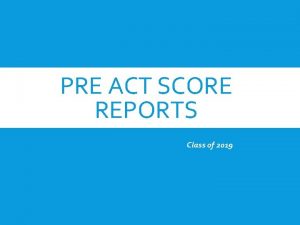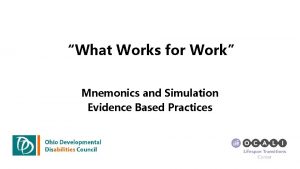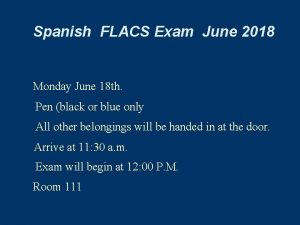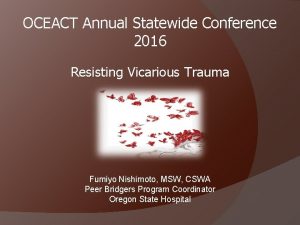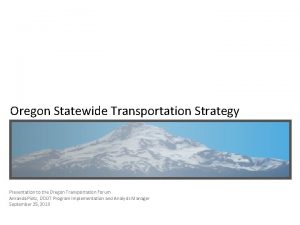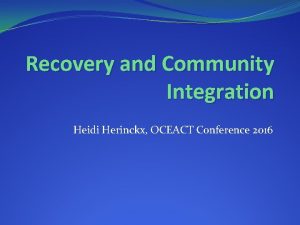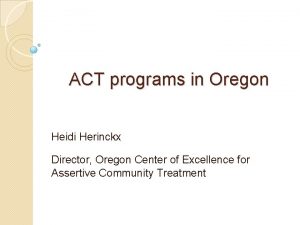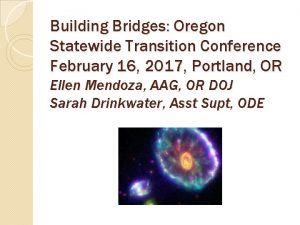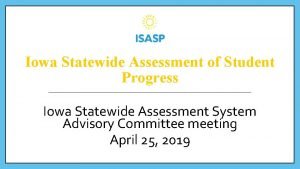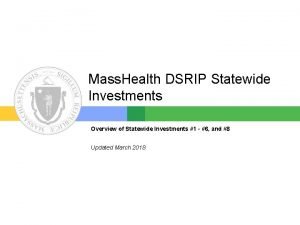OCEACT Statewide Conference June 12 2019 Oregon ACT




































- Slides: 36

OCEACT Statewide Conference June 12, 2019 Oregon ACT Program Outcomes 2018 Heidi Herinckx, M. S. Director of OCEACT hherinckx@optionsonline. org Oregon Center of Excellence for Assertive Community Treatment 1

Who was served by ACT? n n In 2018, a total of 1531 individuals were served in ACT programs state-wide All ACT participants met the ACT eligibility criteria related to diagnosis of serious and persistent mental illness (schizophrenia, bipolar disorder, and other diagnoses with psychotic features). However, 1% had missing diagnostic information. 2

Who was served by ACT? n n n 56% of ACT participants had a co-occurring substance use diagnosis. 3% were US veterans. Most ACT participants were not court involved (85%). n n 7% 2% 4% 2% were on parole or probation; involved with Mental Health Court or Jail Diversion programs; on trial visit, and on PSRB. 3

Demographics of ACT participants n n n The median age was 43. 5 The majority were male 60%; 39% female; 1% transgender or other identified. The majority were Caucasian (75%); Black clients represent 7% of ACT participants served; 6% were American Indians; 3% were Asians ; 4% were Hispanics; 1% were Pacific Islanders and 4% other. 4

Race and Ethnicity: ACT programs compared to State Demographics Oregon ACT Programs N % Oregon State-wide N % American Indian or Alaska Native 98 6% 76, 622 2% Asian 44 3% 191, 554 5% 103 7% 76, 622 2% 1155 75% 2, 911, 617 76% Hispanic Other 55 63 4% 4% 459, 729 76, 622 13% 2% Pacific Islander or Native Hawaiian 13 1% 38, 311 1% 1, 531 100% 3, 831, 075 100% Black or African American Caucasian Total Oregon Population statistics are based on 2010 US Census https: //www. census. gov/quickfacts/fact/table/OR/PST 045218 5

Demographics n n n The majority of ACT participants were single 74%) 25% of ACT participants had less than a high school education; 44% completed high school and the remaining 24% had completed some higher education and 7% had missing data. Most ACT participants were unemployed (76%) at time of enrollment. 6

Living Arrangements by Quarter Apartment or Home Supported or Supportive Housing Foster, Room & Board, Oxford Prison or Jail Residential Facility Homeless, Transitional, Shelter Other Missing Total Q 1 Q 2 Q 3 Q 4 766 (62%) 775(62%) 780 (61%) 816(63%) 67(5%) 89(7%) 104 (8%) 105(8%) 118 (10%) 17 (1%) 57(5%) 126(10%) 11(1%) 43(3%) 113 (9%) 20(2%) 47(4%) 116 (9%) 19(1%) 43(3%) 149 (12%) 41(3%) 11(1%) 149(12%) 43(3%) 11(1%) 163(13%) 54(4%) 7(1%) 149(11%) 60(4%) 0 1226 (100%) 1247(100%) 1288(100%) 1297(100%) 7

Homelessness n n n In 2018, 423 ACT participants (28%) experienced homelessness. The highest rates of homelessness were in the ACT programs serving Multnomah County (Cascadia FACT Team, Central City Concern Core 2, Outside In, NARA Northwest all between 43 - 84%). The lowest rates were in ACT programs serving frontier counties (Center for Human Development, Community Counseling Solutions, Symmetry Care all >8%). 8

Days Homeless by Quarter: 2018 0 Days 1 -15 Days 16 -30 Days 31 -45 Days 45 or more Days Unknown Q 1 Q 2 Q 3 Q 4 1018(83%) 999(80%) 1075(83%) 1097(85%) 20(2%) 29(2%) 13(1%) 22(2%) 14(1%) 49(4%) 10(1%) 14(1%) 5(0%) 8(1%) 22(2%) 7(1%) 165(13%) 162(13%) 168(13%) 157(12%) 4(0%) 0 0 0 1226(100%) 1247(100%) 1288(100%) 1297(100%) 9

Re-hospitalization n n In 2018, 295 individuals (19%) had at least one hospitalization. For those hospitalized, the total number of hospitalizations was 434 and ranged between 1 to 5 hospitalizations per individual. 10

Hospital Locations n The 434 hospitalizations were in the following settings: n n n 212 (13. 8%) went to a psychiatric unit in a hospital; 56 (3. 7%) went to a sub-acute facility; 65 (4. 2%) went to the Oregon State Hospital; 32 (2. 0%) went to another facility (respite or residential); 62 (4%) had missing location information. 11

Hospitalization Length of Stay n n n Of the 295 individuals hospitalized, 268 had both admission dates and discharge dates for their hospitalization. For individuals who were hospitalized, the average number of day spent in the hospital were 40. 7± 56. 6 days per individual. The 268 ACT participants hospitalized spent a total of 10, 912 days hospitalized in 2018. 12

Days Hospitalized in 2018 Days Hospitalized Number of ACT participants Percent 0 1 -7 8 -14 15 -30 31 -60 61 -120 121 -328 Missing Total 1236 67 45 54 45 31 21 26 1531 81% 4% 3% 2% 1. 5% 100% 13

Emergency Room Utilization n Psychiatric Emergency Room Use: 417 (27%) of all ACT participants went to the ER at least once for psychiatric reasons. Medical Emergency Room Use: 570 (37%) of all ACT participants went to the ER at least once for medical reasons. ER Use Combined: Over the 12 months of 2018, 735 (48%) of all ACT participants visited the ER for either psychiatric or medical reasons, or both. 14

Quarterly Rate of ER Visit for Psychiatric Reason and Annual Rate ER Utilization for Psychiatric Reasons 100% 90% 80% 70% 60% 50% 86% 87% 14% 13% Q 1 Q 2 Q 3 Q 4 73% 40% 30% 20% 10% 0% Yes 27% Annual No 15

Quarterly Rate of ER visit for Medical Reason and Annual Rate ER Utilization for Medical Reasons 100% 90% 80% 70% 60% 50% 84% 80% 80% 62% 40% 30% 20% 10% 0% 16% 20% 20% Q 1 Q 2 Q 3 Q 4 Yes 37% Annual No 16

Quarterly Rate of ER visit for ANY Reason and Annual Rate ER Utilization for Any Reason 100% 90% 80% 70% 60% 52% 75% 71% 72% 73% 50% 40% 30% 20% 10% 48% 25% 28% 29% 28% Q 1 Q 2 Q 3 Q 4 0% Yes Annual No 17

Arrests n n In 2018, 242 of 1531 ACT participants (16%) had been arrested. 234 individuals (15%) spent at least one night in jail. 18

Nights in Jail n n The total number of nights spent in jail for all ACT participants was 7372 nights. For the 234 individuals who went to jail, the average days spent in jail was 31. 5± 40. 8. Number 0 nights in jail 1 -2 3 -5 6 -10 11 -30 31 -90 91 -220 Missing Total 1259 53 34 22 48 54 23 38 1531 Percent 82% 3% 2% 1% 3% 4% 2% 2% 100% 19

Comparing Washington ACT teams to Oregon ACT for context n n Annual rate for Washington ACT programs (N=450) In this pre-post study, Washington PACT did not reduce number of individuals who used state hospitals, but did reduce number of days by 33 days person. Slight increase in ER visits, one per year. No change in arrests. Morrissey, J. , Domino, M. Cuddeback, G. (2013) Assessing the Effectiveness of Recovery-Oriented ACT in Reducing State Psychiatric Hospital Use. Psychiatric Services, April Vol 64. No. 4 Annual Utilization WA PACT (N=450) Oregon ACT (N=1531) State and local 293 (62%) psychiatric hospital use 295 (19%) Hospital days (mean±SD) 110± 126 40. 7± 56. 6 ER Visit 113 (25%) 735 (48%) Arrest 158 (35%) 242 (16%) 20

Arrests and Jail in ACT Literature n n n Most ACT studies have shown little effect on rates of arrest and incarceration (Mueser, Bond, Drake, 1998). A review of controlled studies show that 70 percent of ACT randomized control trials had no effect and 10% showed worsening effect on arrest and incarceration (Bond, Drake, Mueser, 2001). Forensic ACT teams (FACT) program adaptations are specifically designed to keep folks out of jail and prison, avoid/reduce arrests, increase service coordination with community corrections. 21

2004 Review of FACT Programs n n n Lamberti, Weisman, Faden, (2004) reviewed 16 FACT programs ACT participants served by the FACT teams had the following characteristics: 56± 22 percent had a diagnosis of schizophrenia 21± 10 percent had a diagnosis of bipolar 89± 12 percent had a co-occurring substance use disorder n n 52± 35 percent were homeless at enrollment 64± 32 percent had previous felony conviction 37± 26 percent had committed a violent crime 55± 39 percent were on probation at time of enrollment 22

2004 Review of FACT Programs n n n Cimino & Jennings (2002) reported FACT participants remained arrest free and without substance abuse while living in community an average of 508 days. Project Link reported reduction in jail days from 107 ± 133. 5 days per participant to 46± 83. 7 per participant (Lamberti, Weisman, Schwarzkopf et al. 2001). In the Thresholds Jail Project, total number of jail days dropped from 2, 741 in the year prior to FACT enrollment to 469 during first year of enrollment in FACT (cited in Lamberti et al. 2004). 23

Alcohol and Drug Use by Quarter Alcohol and Drug Use Q 1 Q 2 Number None Once or twice At least once a month At least once a week Daily or almost daily Multiple times a day Unknown Total Q 3 Percent Number Q 4 Percent Number Percent 558 72 46% 6% 551 78 44% 6% 531 97 41% 8% 535 94 41% 7% 76 6% 72 6% 74 6% 96 7% 172 14% 190 15% 151 12% 170 13% 213 17% 205 16% 239 19% 201 15% 52 4% 62 5% 57 4% 53 4% 83 1226 7% 100% 89 1247 7% 100% 139 1288 11% 100% 148 1297 11% 100% 24

Medication Adherence Q 1 Q 2 Number Q 3 Percent Number Percent Q 4 Number Percent Yes 967 85% 971 83% 1001 84% 1021 84% No 164 15% 194 17% 185 16% 189 16% 1131 100% 1165 100% 1186 100% 1210 100% 25

Supported Employment Q 1 N Total ACT participants Enrolled In SE Competitive Employed Q 2 N % 1226 Q 3 N % 1247 Q 4 N % 1288 ANNUAL N % 1297 % 1531 273 22% 296 24% 317 25% 299 23% 471 31% 87 32% 91 31% 106 33% 101 34% 162 34% 26

Supported Employment Outcomes n n The quarterly rates of enrollment in supported employment were 22%-25%, with the annual rate increasing to 31% of ACT participants who received supported employment services in 2018. Each quarter between 31% and 34% of those who were enrolled in supported employment had worked. This rate is consistent with the overall annual rate of 34%. 27

Education n In 2018, 68 ACT participants (4. 4%) were enrolled in a degree seeking program such as GED, community college, four-year degree or vocational program. 28

ACT Discharges (n=348) 2% 3% Reasons for Discharge Transition to less intensive services 5% Moved out of area 7% Transition to higher level care 27% 4% Client refused care Deceased 8% Agency closure cant find 12% 17% 15% Agency closure incarceration Other Agency closure behavior Missing 29

2018 ACT Program Outcome Summary n n n n n ACT participants have high needs. The vast majority of ACT participants were stably housed (75%-80% each quarter). However, homelessness was experienced by 28% of ACT participants in 2018. 19% of ACT participants were re-hospitalized for a total of 10, 912 hospital days. 48% of ACT participants visited the ER in 2018. Supported Employment enrollment was 31% and competitive employment rate was 34%. 16% of ACT participants were arrested. The number of ACT participants who used alcohol or drugs daily or multiple times daily ranged between 19% and 23% each quarter. The majority of ACT participants (83 -85%) who are prescribed psychiatric medications take them. 30

Next Steps n Disseminate a report that summarizes both the qualitative evaluation of the effectiveness of ACT programs and the quantitative outcomes n n n ACT outcomes from OAD ACT participant focus group data collected from 156 ACT participants in 31 ACT programs ACT stakeholder interviews representing service coordination with community corrections, hospitals and housing programs. 31

Next Steps n n OAD: May refine some of the outcomes as recommended by the data advisory committee Establish a common set of benchmarks for program indicating program improvements n n n 40% of ACT participants enrolled in SE services 40% of those enrolled in SE services will work Establish goals for reduced hospitalization days or ER use and other benchmarks and track outcomes over time to measure improvement 32

Future Analyses n n n Do individuals in ACT who consistently take medications have better outcomes (hospitalization rate, incarceration rate, enrollment in supported employment) than those that don’t? How does daily drug and alcohol use influence outcomes? Are there regional differences, or differences based on population density in ACT program outcomes? 33

Questions n ? ? ? ? ? ? ? ? ? ? ? 34

Contact Information n Heidi Herinckx, Director of OCEACT n n hherinckx@optionsonline. org Also visit the OCEACT website for quarterly OAD outcome reports and updated analyses n www. oceact. org 35

References n n n Bond GR, Drake RE, Mueser KT, et al (2001) Assertive community treatment for people with severe mental illness: critical ingredients and impact on patients. Disease Management and Health Outcomes 9: 141– 159 Cimino T, Jennings JL (2002) Arkansas partnership program: an innovative continuum of care program for dually diagnosed forensic patients. Psychiatric Rehabilitation Skills 6: 104– 114 Lamberti JS, Weisman RL, Schwarzkopf SB, et al (2001) The mentally ill in jails and prisons: towards an integrated model of prevention. Psychiatric Quarterly 72: 63– 77 Lamberti, S. J. , Weisman, R; Faden, D. I. (2004) Forensic Assertive Community Treatment: Preventing Incarceration of Adults with Severe Mental Illness. Psychiatric Services November Vol 55 No 11 1285 -1293 Morrissey, J. , Domino, M. Cuddeback, G. (2013) Assessing the Effectiveness of Recovery-Oriented ACT in Reducing State Psychiatric Hospital Use. Psychiatric Services, April Vol 64. No. 4 Mueser KT, Bond GR, Drake RE, et al (1998) Models of community care for severe mental illness: a review of research on case management. Schizophrenia Bulletin 24: 37– 74 36
 Osas portal.org
Osas portal.org Geometry regents 2019
Geometry regents 2019 2019 june calendar
2019 june calendar Hawaii statewide assessment program
Hawaii statewide assessment program Nova payee services
Nova payee services Statewide health insurance benefits advisors
Statewide health insurance benefits advisors New york statewide senior action council
New york statewide senior action council Statewide community infrastructure program
Statewide community infrastructure program Michigan state industries
Michigan state industries Texas statewide vine service
Texas statewide vine service Statewide construction and development
Statewide construction and development Statewide benefits
Statewide benefits Vinelink texas statewide
Vinelink texas statewide Arizona statewide independent living council
Arizona statewide independent living council Ba conference 2019
Ba conference 2019 Nordic navigation
Nordic navigation Fasfaa conference 2019
Fasfaa conference 2019 Esop conference 2019 las vegas
Esop conference 2019 las vegas Nmls resource center
Nmls resource center Third party risk management conference 2019 new york
Third party risk management conference 2019 new york Executive assistant conference 2019
Executive assistant conference 2019 2019 dod allied nations technical corrosion conference
2019 dod allied nations technical corrosion conference Ppl members
Ppl members Mil-std-889d
Mil-std-889d Png investment conference 2019
Png investment conference 2019 Wind energy science conference 2019
Wind energy science conference 2019 Cdha benefits
Cdha benefits Appa eo conference 2019
Appa eo conference 2019 Deutsche bank high yield conference 2019
Deutsche bank high yield conference 2019 The microcap conference 2019
The microcap conference 2019 Wasfaa conference 2019
Wasfaa conference 2019 Vasfaa conference 2019
Vasfaa conference 2019 Macbeth act 3-5 summary
Macbeth act 3-5 summary Oregon state board of nursing license
Oregon state board of nursing license Act score range
Act score range 30 days has september
30 days has september Flacs exam
Flacs exam
